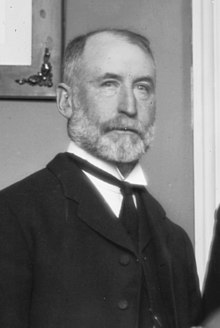William Jay Gaynor
William Jay Gaynor (born February 2, 1848 in Oriskany , New York , † September 10, 1913 in New York City ) was an American lawyer and politician and mayor of New York City .
Life
Gaynor grew up in the country as a child of strict Catholic parents of Irish descent. As a teenager he showed great interest in the church and therefore his parents sent him to a church high school in the neighboring county town of Utica , also for financial reasons . This was maintained by the French community of Brothers of Christian Schools and provided with teachers. The young man did well in school and decided to become a member of the male order.
Gaynor was inducted into the Order in 1863 at the age of 15, taking the name of Brother Adrian Denys; however, he has not yet been ordained. For the next five years he was educated in the brothers' house and he soon began teaching in village and community schools in the Utica area. In 1868 he was selected with a group of the brothers to help shape what would later become Saint Mary's College of California in San Francisco ( California ). The trip went with the steamship Ocean Queen to Aspinwall , today Colón , in today's Panamá , then overland to the Pacific coast and from there by ship to San Francisco. During the trip, however, he had doubts about his calling and so he returned to his family in Utica that same year.
Career as a lawyer and politician
His father referred Gaynor to the law firm Horatio & John Seymour so that he could prepare for law school. During this time he came into contact with politics, since Horatio Seymour had been governor of New York State in the previous years and had lost the election as US president to Ulysses S. Grant in 1868 .
In 1893 Gaynor was nominated for a seat on the Supreme Court of New York State by the Tammany Hall establishment and was also elected in 1893. His reputation as an honest and reformist judges in 1905 after the Court of Appeal was called the Supreme Court. In 1909 he won the election of New York City Mayor as a representative of the Democrats, and so he was able to walk from his home in Park Slope , Brooklyn to City Hall , the city hall in Manhattan , on January 1, 1910 .
Gayner broke off his ties to Tammany Hall soon after taking up the job. For example, he filled high civil servant posts with suitable specialists, and employees of the city were hired and promoted without the hitherto known nepotism or the widespread bribe payments. The obstacles caused by tactical maneuvers in the expansion of the New York City subway system have been removed.
Last years and death
On August 9, 1910 Gaynor was on board the German passenger liner Kaiser Wilhelm der Grosse , which at the dock of the North German Lloyd in Hoboken ( New Jersey hit was), by two bullets from the revolver of a former, dismissed municipal employees in mind. He survived the attack; assassin James J. Gallagher was caught and sentenced; He died in 1913 in prison in Trenton to paresis .
Gaynor wanted to run for president of the United States and in 1913 was run as a candidate for a second term as New York City mayor by an independent group of voters. Tammany Hall had refused to support the politician. On September 10, 1913, while preparing for a trip to Europe, the mayor died of the aftermath of the assassination attempt three years ago because a bullet was still stuck in his cervical vertebrae. He was succeeded by Ardolph Loges Kline .
literature
- Thomas Lately: The Man who Mastered New York . William Morrow & Co., New York 1969
- William Gaynor: Some of Mayor Gaynor's Letters and Speeches . Greaves Publishing Company, New York 1913
Web links
| predecessor | Office | successor |
|---|---|---|
| George B. McClellan Jr. |
Mayor of New York City 1910 - 1913 |
Ardolph Loges Kline |
| personal data | |
|---|---|
| SURNAME | Gaynor, William Jay |
| BRIEF DESCRIPTION | American lawyer and politician |
| DATE OF BIRTH | February 2, 1848 |
| PLACE OF BIRTH | Oriskany , New York |
| DATE OF DEATH | September 10, 1913 |
| Place of death | New York City |
